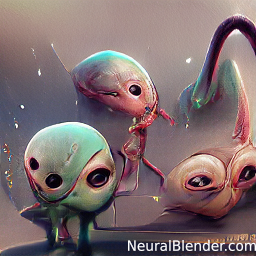Artificial Intelligence (AI) has revolutionized countless industries, and one of the most creative frontiers it’s impacted is art. Among the most intriguing tools in this domain is NeuralBlender, an AI-driven image generator that allows users to create stunning and surreal visual art based on text input. This tool blends neural networks, deep learning, and user inputs to produce fascinating visuals, making AI more accessible to artists and non-artists alike.
In this comprehensive guide, we will explore what NeuralBlender is, how it works, its applications, and what sets it apart from other AI art generators. We will also look at practical use cases, limitations, and provide answers to common questions users may have about the tool.
What is NeuralBlender?
NeuralBlender is an online platform that uses AI and deep learning algorithms to create images based on simple text descriptions provided by the user. The tool taps into neural networks—the cornerstone of AI technology—to interpret written commands and translate them into corresponding visual representations.
These images often take on abstract or surreal characteristics, as the AI is designed to “blend” concepts in imaginative and unexpected ways. This makes NeuralBlender particularly popular among digital artists, content creators, and individuals curious about exploring AI’s creative potential.
How Does NeuralBlender Work?
NeuralBlender operates by leveraging deep neural networks, which are designed to mimic the way the human brain processes information. Here’s a breakdown of how it works:
- Text Input: The user inputs a description or set of instructions for the type of image they want to generate. This can range from a simple phrase like “sunset over mountains” to more complex and abstract ideas like “a dreamscape of floating islands and neon skies.”
- AI Processing: The system uses Natural Language Processing (NLP) to understand the user’s input and break it down into components that can be visually represented. It then taps into a database of image patterns to match these components with visual representations.
- Image Generation: The neural network processes these components, blends them together, and generates an image. The outcome may not always be photorealistic, but it typically captures the essence of the user’s description.
- Iterations and Refinements: Users can make adjustments to their input or request a new iteration if they want a different interpretation of the same idea.
Applications of NeuralBlender
While NeuralBlender’s primary appeal lies in its ability to create art, its applications stretch far beyond that. Here are some key areas where NeuralBlender can be particularly useful:
1. Digital Art Creation
For digital artists, NeuralBlender provides a unique way to create abstract, surreal, or dream-like imagery without needing technical drawing skills. Artists can input prompts and get outputs that they can further refine or incorporate into larger projects. This process enables artists to experiment with new styles and concepts quickly.
2. Content Creation and Social Media
Visual content is key to engaging audiences on social media, blogs, and websites. NeuralBlender can help content creators generate eye-catching and unique visuals that complement their written or spoken content. Whether you’re crafting posts for Instagram or designing a cover for a blog article, AI-generated images offer a fresh, creative touch.
3. Marketing and Branding
Brands that wish to differentiate themselves can use NeuralBlender to create visually stunning marketing materials, from social media posts to logos and promotional images. By generating images that are uniquely tailored to a brand’s voice and style, marketers can build a distinctive visual identity.
4. Game Design and Concept Art
In the world of video games, movies, and other media, concept art plays a crucial role in early-stage design. NeuralBlender can help game developers and designers come up with quick visual concepts, especially for fantasy or sci-fi projects that require otherworldly visuals. The AI’s ability to create abstract and surreal images makes it perfect for generating fantastical environments, creatures, and items.
5. Educational Purposes
NeuralBlender can be a valuable tool in educational settings, especially in subjects like art, design, and even psychology. Teachers and students can explore the intersection of creativity and AI, discuss how neural networks interpret data, or use the tool to analyze how abstract ideas can be translated into visual formats.
Features of NeuralBlender
1. User-Friendly Interface
NeuralBlender’s platform is designed to be easy for anyone to use, regardless of technical background. Users can simply enter their desired text, and the AI does the heavy lifting. The minimalistic interface makes the process intuitive.
2. Customizable Output
Users can guide the AI in creating a wide variety of styles, from abstract to surreal, making NeuralBlender an incredibly versatile tool. Whether you’re looking for a realistic scene or a fantastical creation, the tool allows for flexibility in artistic direction.
3. Multiple Iterations
NeuralBlender allows for multiple iterations of an image, meaning users can refine their image by slightly altering the input or requesting the AI to take a different approach. This enables creators to perfect their designs over time.
4. Accessibility
The platform is web-based, meaning it is accessible from virtually any device with an internet connection, and doesn’t require expensive hardware or advanced graphic design skills.
What Sets NeuralBlender Apart?
In a growing market of AI art generators, NeuralBlender stands out for several reasons:
- Imaginative Outputs: Unlike other AI tools that aim for photorealism, NeuralBlender specializes in more imaginative, abstract, and surreal images. This makes it a go-to for creators looking for visuals that challenge the norm and inspire curiosity.
- Rapid Prototyping: NeuralBlender is an excellent tool for rapid image generation, allowing artists and designers to quickly explore new ideas and iterate on concepts.
- Community and Collaboration: NeuralBlender has an active user community where creators share their AI-generated artwork. This helps inspire others and fosters a collaborative environment for innovation and experimentation.
Limitations of NeuralBlender
While NeuralBlender is an incredibly powerful tool, it is not without its limitations:
- Abstract Nature: The tool’s output is often abstract, which can be a limitation for users seeking more realistic or detailed visuals. The AI’s imaginative interpretation of text can sometimes be too far removed from the user’s intent.
- Limited Control: Although you can refine the output by adjusting the text input, the user still has limited control over the fine details of the generated image. For highly specific artistic needs, this can be a challenge.
- Complex Descriptions: Sometimes, the AI may struggle to fully capture the nuances of a very complex or abstract prompt, leading to outputs that may not align with the user’s expectations.
FAQs about NeuralBlender
1. What is NeuralBlender?
NeuralBlender is an AI-driven tool that creates images based on user-provided text descriptions. The tool uses neural networks to process the text and generate unique visuals, often in an abstract or surreal style.
2. How does NeuralBlender work?
The user inputs a text prompt, which the AI analyzes using Natural Language Processing (NLP). The AI then blends concepts into an image based on the description provided, producing a creative or abstract interpretation.
3. Who can use NeuralBlender?
NeuralBlender is designed for anyone interested in creating visual art through AI. Whether you’re an artist, designer, marketer, or someone looking to experiment with AI art, the platform is easy to use and accessible to all.
4. Is NeuralBlender free to use?
While NeuralBlender offers a free tier for casual use, there may be premium options that allow for more image generations or higher resolution outputs. Specific pricing and membership details can vary.
5. Can I use Neural Blender for commercial purposes?
Always check the platform’s licensing terms for image usage. Many AI tools allow for commercial use, but it’s important to understand any specific restrictions or requirements.
6. Can Neural Blender generate photorealistic images?
Neural Blender is better suited for abstract and surreal imagery rather than photorealism. If you’re looking for highly detailed, lifelike images, other AI art generators might be more appropriate.
7. How does Neural Blender compare to other AI art tools?
Neural Blender is known for its imaginative and abstract outputs. While other tools might focus on realism or specific art styles, Neural Blender’s strength lies in blending concepts in surprising and creative ways.
8. Can I adjust the style of images generated by Neural Blender?
To some extent, yes. The style of the image can be influenced by the phrasing and content of the text input. However, the tool ultimately makes its own creative decisions based on the neural network’s interpretation.
9. Is Neural Blender safe to use?
Yes, Neural Blender is generally safe to use, and the platform respects user privacy. However, as with any online platform, it’s wise to review the terms and conditions, especially concerning data handling.
10. What kind of text input works best for Neural Blender?
Short, descriptive prompts work best, but you can experiment with more complex inputs. The tool excels at creating imaginative and abstract interpretations, so don’t hesitate to get creative with your descriptions.
Conclusion
NeuralBlender is a fascinating tool that merges AI with the artistic world, offering users an easy way to generate unique, surreal, and imaginative images based on simple text prompts. Whether you are a digital artist, a content creator, or someone who just loves exploring the creative potential of AI, Neural Blender opens up a new avenue for artistic.



